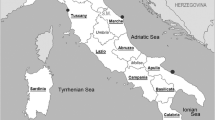Abstract
The aquatic world is renowned for its enchanting beauty. In some cases, however, hidden perils may lurk behind the alluring beauty, and even some mortal dangers. An analysis of the map of the hydrosphere shows that the central hub for potentially harmful aquatic animals is the great area of the Indian and Pacific Oceans, although aquatic animals and vegetables of less aggressive type are present in all the seas. Of the two types of offense and defense mechanisms possessed by many marine fauna, namely physical and chemical, study of the latter has always been a fascinating sector of marine biology, still to some extent veiled in an aura of mystery. Many animal and vegetable species are equipped with biotoxins, organic products that can be poisonous (harmful when eaten) or venomous (harmful when they enter the bloodstream), and have various different actions and variable pathogenic intensities. These biotoxins can be actively produced, or else derive from the aquatic environment for various reasons. In the latter case the animals are carriers of biotoxins. To date, few biotoxins have been isolated, of variable chemical natures, and with a few exceptions, no specific antidotes have yet been discovered.
Access this chapter
Tax calculation will be finalised at checkout
Purchases are for personal use only
Similar content being viewed by others
References
Williamson JA, Fenner PJ, Burnett JW et al (1966) Venomous and poisonous marine animals. A medical and biologic handbook. University of New South Wales Press, Sydney
Halstead BW (1992) Dangerous aquatic animals of the world: a color atlas. The Darwin Press Inc/Mosby Year Book, Princeton/Saint Louis
Banister K, Campbell A (eds) (1993) The encyclopedia of aquatic life. Facts on File, Inc, New York
Kaplan EH (1982) Coral reefs. Houghton Mifflin Company, Boston
Ghiretti F, Cariello L (1984) Gli animali marini velenosi e le loro tossine. Piccin, Padova, p 7
Banner AM (1967) Marine toxins from the Pacific. I. Advances in the investigations of fish toxins. In: Russel FE, Saunders PS (eds) Animal toxins. Pergamon Press, Oxford, p 157
Der Marderosian A (1968) Current status of drug compounds from marine sources. In: Freudenthal HD (ed) Drugs from the sea. Marine Technological Society, Washington, DC, p 19
Baslow MH (1969) Marine pharmacology. The Williams and Williams Co, Baltimore
Bucherl W, Buckley EE (1971) Venomous animals and their venoms. Academic, New York
Humm HJ, Lane CE (1974) Bioactive compounds from the sea. M Dekker Inc, New York
Russell FE, Brodie AF (1974) Toxicology: venomous and poisonous marine animals. In: Mariscal RC (ed) Experimental marine biology. Academic, New York, p 269
Ruggieri GD (1976) Drugs from the sea. Science 194:491
Scheuer PJ (1978) Marine natural products. Academic, New York
Hashimoto Y (1979) Marine toxins and other bioactive marine metabolites. Japan Scientific Society Press, Tokyo
Eaker D, Wadström T (1980) Natural toxins. Pergamon Press, Oxford
Habermehl GG (1981) Venomous animals and their toxins. Springer, Heidelberg/New York/Berlin
Botana LM (ed) (2014) Seafood and freshwater toxins: pharmacology, physiology and detection, 3rd edn. CRC Press, Boca Raton
Author information
Authors and Affiliations
Corresponding author
Editor information
Editors and Affiliations
Rights and permissions
Copyright information
© 2016 Springer International Publishing Switzerland
About this chapter
Cite this chapter
Bonamonte, D., Angelini, G. (2016). The Aquatic Biotic Environment and Its Biotoxins. In: Bonamonte, D., Angelini, G. (eds) Aquatic Dermatology. Springer, Cham. https://doi.org/10.1007/978-3-319-40615-2_2
Download citation
DOI: https://doi.org/10.1007/978-3-319-40615-2_2
Published:
Publisher Name: Springer, Cham
Print ISBN: 978-3-319-40614-5
Online ISBN: 978-3-319-40615-2
eBook Packages: MedicineMedicine (R0)




